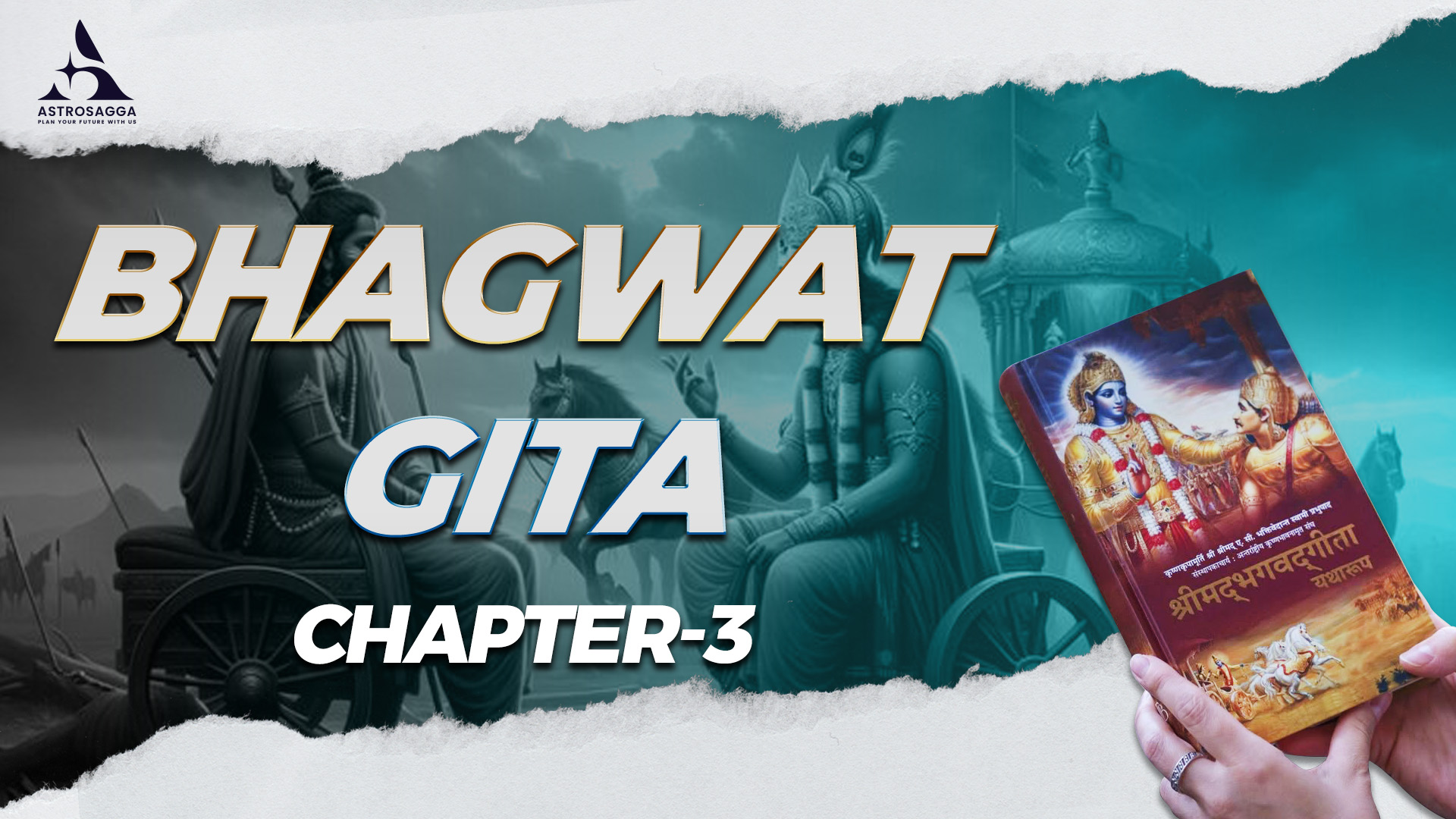The Bhagavad Gita is not merely a religious scripture; it is a timeless guide to living a life filled with purpose, discipline, and peace. Bhagavad Gita Chapter 3, titled Karma Yoga or The Path of Action, offers practical life lessons that remain highly relevant even today.
In this chapter, Lord Krishna explains the importance of doing one’s duty selflessly. He tells Arjuna that action is better than inaction and that every person must perform their responsibilities without attachment to outcomes. Let’s understand the deeper wisdom of Bhagavad Gita Chapter 3 and how it can help us lead a better life.
Read Also - Bhagavad Gita Chapter 1: Practical Tips for Life
What is Karma Yoga?
Karma Yoga means performing your duties with dedication but without attachment to the results. It is one of the core messages of Bhagavad Gita Chapter 3.
श्लोक 1:
कर्मण्येवाधिकारस्ते मा फलेषु कदाचन।
मा कर्मफलहेतुर्भूर्मा ते सङ्गोऽस्त्वकर्मणि॥
(Chapter 3, Verse 47)
Meaning: You have the right to work, but never to the fruit of your work. Don’t let the outcome be your motive, and don’t get attached to inaction.
Lesson: Focus on doing your karma sincerely. Leave the results to the divine will.
This mindset reduces stress, boosts focus, and leads to peace of mind. When we give our best and let go of the worry about results, we grow spiritually and emotionally.
The Necessity of Action
Arjuna initially wants to escape the battlefield, but Krishna tells him that no one can live without action — it is part of nature.
श्लोक 2:
न हि कश्चित्क्षणमपि जातु तिष्ठत्यकर्मकृत्।
कार्यते ह्यवशः कर्म सर्वः प्रकृतिजैर्गुणैः॥
(Chapter 3, Verse 5)
Meaning: No one can remain inactive even for a moment. Everyone is forced to act by the qualities of nature.
Lesson: Life is action. What matters is how you act — with awareness or ignorance.
From breathing to thinking, action is constant. Therefore, rather than escaping work, we should learn to purify it through purpose and attitude.
Do Your Duty – Not Someone Else's
Krishna advises that it’s better to do one’s own duties imperfectly than to perform someone else’s perfectly.
“Shreyān svadharmo viguṇaḥ, para-dharmāt svanuṣṭhitāt”
It means your swadharma (personal duty) is always more important than paradharma (someone else's duty), even if it seems less rewarding.
Lesson: Stay true to your path. Every role has spiritual importance if done sincerely.
Selfless Action is the Key
The Gita emphasizes Yajna, or sacrificial action — work done as a contribution to the world.
श्लोक 3:
यज्ञार्थात्कर्मणोऽन्यत्र लोकोऽयं कर्मबन्धनः।
तदर्थं कर्म कौन्तेय मुक्तसङ्गः समाचर॥
(Chapter 3, Verse 9)
Meaning: Work done as a selfless offering liberates us. Work done for selfish reasons binds us.
Lesson: Whatever you do, do it for a higher purpose — your family, society, or God. Work becomes worship.
Read Also - Bhagavad Gita Chapter 2: Life Lessons for All
Don't Escape Your Responsibilities
Many people think spirituality means sitting quietly in meditation or renouncing duties. Krishna disagrees.
He warns against pretending to be detached while secretly being attached to desires.
Lesson: True spirituality is not escape — it is fulfilling your worldly duties with a pure heart and no expectations.
Lead by Example
Leadership is a central teaching of Bhagavad Gita Chapter 3. People follow what leaders do.
श्लोक 4:
यद्यदाचरति श्रेष्ठस्तत्तदेवेतरो जनः।
स यत्प्रमाणं कुरुते लोकस्तदनुवर्तते॥
(Chapter 3, Verse 21)
Meaning: Whatever great people do, others follow. Whatever standards they set, the world imitates.
Lesson: Be the change. Set the standard through your actions, not just words.
Whether you’re a teacher, parent, or employer, your conduct influences others deeply.
Let Go of the Fruits of Action
Non-attachment does not mean being careless. It means working with commitment and not getting disturbed by success or failure.
When we expect too much from our actions, we often get anxious or disappointed. Letting go of that attachment leads to inner calm.
Lesson: Do your work with full heart — but stay emotionally detached from the outcome.
Control Desire and Anger
Krishna identifies desire (kama) and anger (krodha) as the biggest enemies of the soul.
श्लोक 5:
काम एष क्रोध एष रजोगुणसमुद्भवः।
महाशनो महापाप्मा विद्ध्येनमिह वैरिणम्॥
(Chapter 3, Verse 37)
Meaning: It is desire and anger, born of passion, which devour peace and are the enemy of the soul.
Lesson: Don’t become a slave to your desires or temper. Practice control and awareness.
These emotions cloud judgment and lead to actions we later regret. Control over them leads to clarity and spiritual growth.
Apply It in Daily Life
Here’s how you can apply the teachings of Bhagavad Gita Chapter 3 in real life:
In career: Work with dedication. Don’t obsess over promotions or praise.
In family: Serve with love and without expectation.
In studies: Study for learning, not just marks.
In tough times: Stay focused on the right action, not the fear of failure.
In relationships: Act selflessly, not out of ego or desire.
These practices help build a peaceful, balanced, and purposeful life.
Conclusion
Bhagavad Gita Chapter 3 teaches us that life is action, and that selfless action is the path to peace and spiritual evolution. By performing our duties sincerely, without selfish motives or fear of failure, we align ourselves with the divine will.
The chapter is not just spiritual theory — it's a practical guide to a better life. Whether you are a student, parent, employee, or spiritual seeker, the teachings of Karma Yoga apply to everyone.
When we live by the wisdom of this chapter, we gain strength, clarity, and deep inner peace. Work becomes worship, and life becomes meaningful.
Still confused about your life path or karma? Speak to a trusted Vedic astrologer today and discover how Bhagavad Gita Chapter 3 connects with your personal horoscope and spiritual growth.
Talk to astrologer now and align your actions with your higher purpose.
FAQs –
1. What is the main message of Bhagavad Gita Chapter 3?
Answer: The main message is that we should perform our duties selflessly without attachment to the results. This path is known as Karma Yoga.
2. What does Karma Yoga mean in Bhagavad Gita Chapter 3?
Answer: Karma Yoga is the practice of doing your responsibilities sincerely and without expecting rewards. It teaches action with devotion and detachment.
3. Why does Krishna emphasize action in Bhagavad Gita Chapter 3?
Answer: Krishna explains that no one can live without acting. Action is a part of life, and when done selflessly, it leads to inner peace and spiritual growth.
4. How can I practice the teachings of Bhagavad Gita Chapter 3 in daily life?
Answer: Do your duties with honesty, avoid expecting results, serve others, and stay calm in both success and failure. That’s practical Karma Yoga.
5. What is the meaning of the famous verse ‘Karmanye vadhikaraste...’?
Answer: It means you have the right to perform your duty, but not to control its outcome. Focus on your actions, not on the fruits.
6. Is renunciation better than action according to Bhagavad Gita Chapter 3?
Answer: No. Krishna clearly says action is superior. Renouncing duties without understanding is not spiritual; true spirituality is working with detachment.
7. What are the enemies of peace mentioned in Chapter 3?
Answer: Desire (Kama) and Anger (Krodha) are identified as enemies. They arise from passion and lead to unrest, if not controlled.
8. Who should read Bhagavad Gita Chapter 3?
Answer: Everyone — students, professionals, parents, and spiritual seekers — as it gives universal lessons on duty, balance, and peace of mind.
9. How does Bhagavad Gita Chapter 3 view leadership?
Answer: It teaches that great people must lead by example. Their actions inspire others, so leaders should act responsibly and ethically.
10. Can Bhagavad Gita Chapter 3 help reduce stress?
Answer: Yes. When you focus on your work and let go of results, it reduces anxiety, expectations, and disappointment — leading to mental peace.












